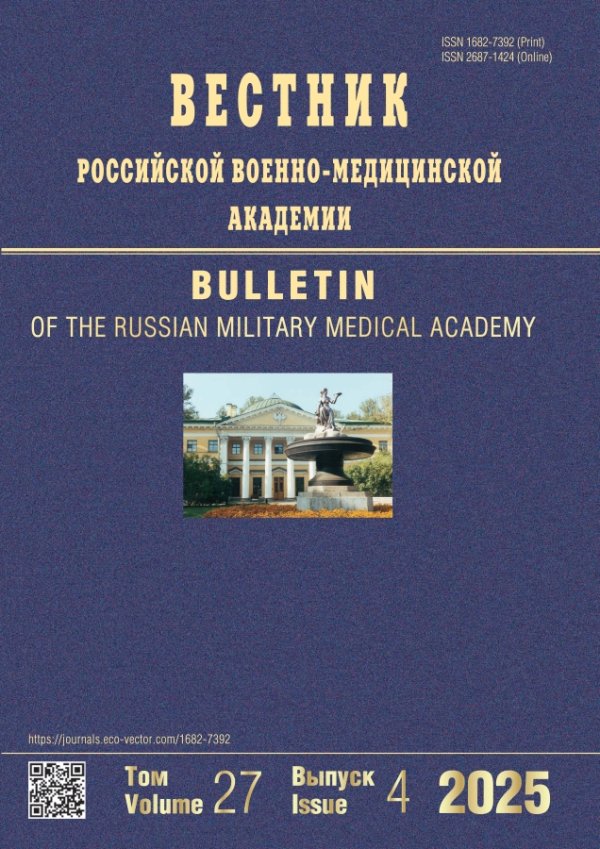Экспериментальное моделирование в современной раневой баллистике
- Авторы: Денисов АВ1, Анисин АВ1, Логаткин СМ1, Демченко КН1, Озерецковский ЛБ1
-
Учреждения:
- Военно-медицинская академия им. С.М. Кирова
- Выпуск: Том 20, № 2 (2018)
- Страницы: 144-149
- Раздел: Статьи
- URL: https://journals.rcsi.science/1682-7392/article/view/12300
- DOI: https://doi.org/10.17816/brmma12300
- ID: 12300
Цитировать
Полный текст
Аннотация
Полный текст
Открыть статью на сайте журналаОб авторах
А В Денисов
Военно-медицинская академия им. С.М. Кирова
Email: denav80@mail.ru
Санкт-Петербург
А В Анисин
Военно-медицинская академия им. С.М. КироваСанкт-Петербург
С М Логаткин
Военно-медицинская академия им. С.М. КироваСанкт-Петербург
К Н Демченко
Военно-медицинская академия им. С.М. КироваСанкт-Петербург
Л Б Озерецковский
Военно-медицинская академия им. С.М. КироваСанкт-Петербург
Список литературы
- Анисин, А.В. Особенности минно-взрывных повреждений при использовании специальных средств защиты сапера: дис. … канд. мед. наук / А.В. Анисин. - СПб., 2011. - 123 с.
- Гальцев, Ю.В. Моделирование ранений из огнестрельного оружия в медицине / Ю.В. Гальцев // Мат. межвед. меж- регион. науч.-практич. конф. 20-21 ноября 1997 г. - СПб., 1997. - С. 195-197.
- Даренская, Н.Г. Экстраполяция экспериментальных данных на человека в физиологии и радиобиологии: принципы, под- ходы, обоснование методов и их использование в физио- логии и радиобиологии: руководство / Н.Г. Даренская [и др.]. - М.: Истоки, 2004. - 232 с.
- Денисов, А.В. Глицериновое мыло в качестве имитатора биологических мягких тканей в экспериментах по раневой баллистике / А.В. Денисов [и др.] // Судебная экспертиза. - 2016. - № 1 (45). - С. 73-83.
- Денисов, А.В. Особенности поражения живых целей в зоне рикошета пуль при стрельбе по твёрдым преградам / А.В. Денисов [и др.] // Вестн. Росс. воен.-мед. акад. - 2014. - № 1 (45). - С. 179-183.
- Денисов, А.В. Ультраструктурные изменения костной ткани при огнестрельных ранениях и пути их коррекции: авто- реф. дис. …канд. мед. наук / А.В. Денисов. - СПб.: ВМА, 2010. - 20 с.
- Караваева, И.Е. К вопросу моделирования огнестрельных по- вреждений / И.Е. Караваева // Мат. междунар. науч.-практ. конф., посвящ. памяти В.О. Плаксина. - М.: ЮрИнфоЗдрав, 2011. - С. 129-132.
- Кобылкин, И.Ф. Биомеханическая модель взаимодействия непроникающих поражающих элементов с биообъектом / И.Ф. Кобылкин, А.Ю. Летников // Вопросы оборонной техники. - 2003. - Сер. 16, вып. 11-12. - С. 46-51.
- Логаткин, С.М. О целесообразности применения термина «заброневая контузионная травма» при оценке качества бронеодежды / С.М. Логаткин // Вопросы оборонной техники. Сер. 16: Технические средства противодействия терроризму. - 2011. - № 7-8. - С. 77-80.
- Озерецковский, Л.Б. Раневая баллистика: история и со- временное состояние огнестрельного оружия и средств индивидуальной бронезащиты / Л.Б. Озерцовский, Е.К. Гуманенко, В.В. Бояринцев. - СПб.: Журнал Калашников, 2006. - 374 с.
- Храмова, Ю.Р. Экспериментальное животное: основы право- вого регулирования / Ю.Р. Храмова // Мед. право. - 2004. - №. 2. - С. 20-24.
- Шалимов С.А. Руководство по экспериментальной хирургии / С.А. Шалимов, А.П. Радзиховский, Л.В. Кейсевич. - М.: Медицина, 1989. - 271 с.
- Штейнле, А.В. Методология моделирования огнестрельных ранений конечностей / А.В. Штейнле [и др.] // Сиб. мед. журн. - 2008. - Т. 23, № 1. - С. 74-81.
- Berlin, R., Janzon B., Rybeck B. Local effect of assault rifle bullets / R. Berlin, B. Janzon, B. Rybeck // Acta Chir. Scand. - 1977. - Suppl. 477. - P. 5-48.
- Kneubuehl, B. Wundballistik: Grundlagen und Anwendungen / B. Kneubuehl [et al.] - Berlin: Springer Medizin Verlag Heidelberg, 2008. - 492 p.
- Kokinakis, W., Neadles D., Piddington M., Roecker E. A gelatin energy methodology for estimating vulnerability of personnel to military rifle systems / W. Kokinakis [et al.] // Acta Chir. Scand. - 1979. - Suppl. 489. - P. 35.
- Russell, W.M.S. The Principles of Humane Experimental Technique / W.M.S. Russell, R.L. Burch // Methuen. - London: 1959. - Р. 88-91.
- Schantz, B. Aspects on the choice of experimental animals when reproducing missile trauma / B. Schantz // Wundballistik: Acta Chir. Scand. Suppl. - 1979. - Vol. 489. - P. 121-130.
Дополнительные файлы







